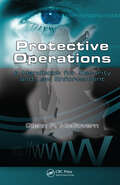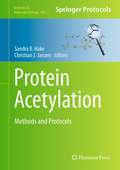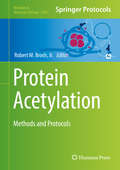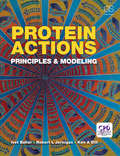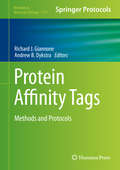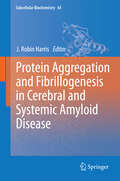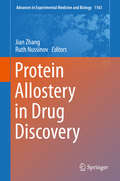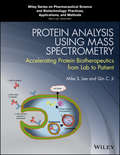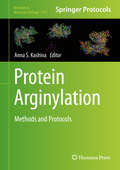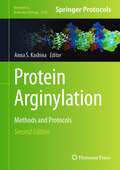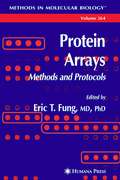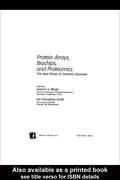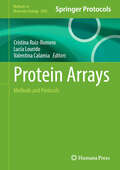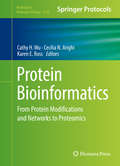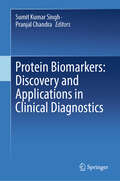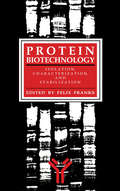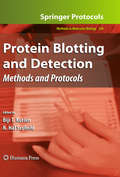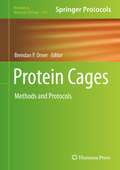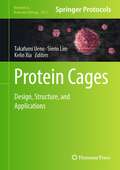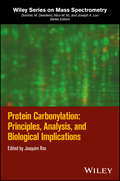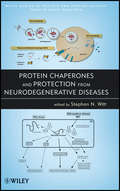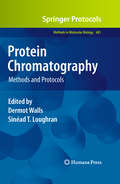- Table View
- List View
Protective Measurement and Quantum Reality
by Shan GaoProtective measurements offer an intriguing method for measuring the wave function of a single quantum system. With contributions from leading physicists and philosophers of physics - including two of the original discoverers of this important method - this book explores the concept of protective measurement, investigating its broad applications and deep implications. Addressing both physical and philosophical aspects, it covers a diverse range of topics, including experimental possibility of protective measurements, connections with the PBR theorem, and the implications of protective measurements for understanding the nature of quantum reality. Including a clear and concise introduction to standard quantum mechanics, conventional measurements, and the fundamentals of protective measurements, this is a valuable resource for graduate students and researchers interested in the conceptual foundations of quantum mechanics.
Protective Operations: A Handbook for Security and Law Enforcement
by Glenn McGovernA reference for law enforcement and security organizations tasked with protecting the welfare of an individual or groups of individuals, this volume offers suggestions and guidance for confronting high-threat scenarios as well as the more mundane protective details. Detailing the essence of protective operations that are run, in large part, covertly, the book explores operational security, situational awareness, and surveillance detection and includes examples from real-world attacks occurring over the past sixty years. Focusing on the economics of providing the most protection for the least cost, it also addresses issues surrounding possible direct violations of the law and department policy and procedures.
Protein Acetylation
by Christian J Janzen Sandra B HakeThousands of proteins have been identified to be acetylated. Immense research power has been dedicated to experiments to solve the biological implications of each and every protein acetylation. Two particular sites of protein acetylation have been described intensively: the N-terminal methionine residue of a nascent protein and lysine residues within a protein. In Protein Acetylation: Methods and Protocols, expert researchers in the field detail many of the methods which are now commonly used to study protein acetylation. These include methods and techniques for identification of protein acetylation, column- and gel electrophoresis-based approaches, computationally prediction, and the biological response to protein acetylation. Written in the highly successful Methods in Molecular BiologyTM series format, chapters include introductions to their respective topics, lists of the necessary materials and reagents, step-by-step, readily reproducible laboratory protocols, and key tips on troubleshooting and avoiding known pitfalls. Authoritative and practical, Protein Acetylation: Methods and Protocols seeks to aid scientists in the further study of the technical aspects involved in understanding protein acetylation.
Protein Acetylation: Methods and Protocols (Methods in Molecular Biology #1983)
by Robert M. Brosh Jr.The book focuses on the regulation of protein function and biological activity by the post-translational modification known as acetylation. Chapters detail a wide range of topics in protein acetylation dealing with pathways relevant to cellular homeostasis, gene expression, and DNA metabolism. Written in the highly successful Methods in Molecular Biology series format, chapters include introductions to their respective topics, lists of the necessary materials and reagents, step-by-step, readily reproducible laboratory protocols, and tips on troubleshooting and avoiding known pitfalls.Authoritative and cutting-edge, Protein Acetylation: Methods and Protocols aims to be an extremely valuable resource to novices and experts alike whose research takes them in the direction of characterizing regulatory switches in protein acetylation events, and how they are manifested in significant ways in diverse mechanisms biological systems.
Protein Actions: Principles and Modeling
by Ken Dill Robert L. Jernigan Ivet BaharProtein Actions: Principles and Modeling is aimed at graduates, advanced undergraduates, and any professional who seeks an introduction to the biological, chemical, and physical properties of proteins. Broadly accessible to biophysicists and biochemists, it will be particularly useful to student and professional structural biologists and molecular biophysicists, bioinformaticians and computational biologists, biological chemists (particularly drug designers) and molecular bioengineers. The book begins by introducing the basic principles of protein structure and function. Some readers will be familiar with aspects of this, but the authors build up a more quantitative approach than their competitors. Emphasizing concepts and theory rather than experimental techniques, the book shows how proteins can be analyzed using the disciplines of elementary statistical mechanics, energetics, and kinetics. These chapters illuminate how proteins attain biologically active states and the properties of those states. The book ends with a synopsis the roles of computational biology and bioinformatics in protein science.
Protein Affinity Tags
by Richard J. Giannone Andrew B. DykstraProtein Affinity Tags: Methods and Protocols provides researchers with the necessary information, tools, and strategy required for proper inquiry into a given protein's function and structure. Today's researchers can easily alter the amino acid sequence of any given protein, a powerful technology allowing for the precise engineering of specific proteins. Protein affinity tagging employs the use of known protein binding interactions in order to "fish out" a protein-of-interest or, with more advanced tags, a protein complex. This technology paired with recent advancements in DNA sequencing technology promises a future that is awash with novel genomic information - information that will not only expand our knowledge of the processes that govern life, but also fuel innovation that will undoubtedly conquer many of today's most salient health and environmental challenges. Written in the successful Methods in Molecular Biology series format, chapters include introductions to their respective topics, lists of the necessary materials and reagents, step-by-step, readily reproducible protocols, and notes on troubleshooting and avoiding known pitfalls. Authoritative and easily accessible, Protein Affinity Tags: Methods and Protocols will be an invaluable resource to those seeking to employ protein affinity tags to study their biological system of interest.
Protein Aggregation and Fibrillogenesis in Cerebral and Systemic Amyloid Disease (Subcellular Biochemistry #65)
by J. Robin HarrisThis volume of the Subcellular Biochemistry series is the result of the long-standing research interest of the editor in the molecular mechanism underlying Alzheimer's disease and other amyloid diseases, indicated also by the earlier book in the series (Volume 38), devoted to Alzheimer's disease. The broad coverage within the present amyloidogenesis book represents an attempt to collate current knowledge relating to the proteins and peptides involved in most of the known amyloid diseases, together with some amyloid/fibril-forming proteins and peptides that are not involved in diseases. Thus, the range of topics included is comprehensive and furthermore it was thought appropriate to include both basic science and clinical presentation of the subjects under discussion.
Protein Aggregation: Methods and Protocols (Methods in Molecular Biology #2551)
by Andrzej Stanisław CieplakThe volume details techniques, methods, and conceptual developments to further the study of protein aggregation with emphasis on the pleiomorphic proteins implicated in etiology of neurodegeneration. Chapters guide readers through in vitro and in vivo studies of fibrillization and liquid-liquid phase separation processes, and offer a comprehensive account of the state-of-art of structural studies of protein aggregation. Written in the format of the highly successful Methods in Molecular Biology series, each chapter includes an introduction to the topic, lists necessary materials and reagents, includes tips on troubleshooting and known pitfalls, and step-by-step, readily reproducible protocols. Authoritative and cutting-edge, Protein Aggregation: Methods and Protocols aims to be useful and practical guide to new researchers and experts looking to expand their knowledge.
Protein Allostery in Drug Discovery (Advances in Experimental Medicine and Biology #1163)
by Ruth Nussinov Jian ZhangThe book focuses on protein allostery in drug discovery. Allosteric regulation, ʹthe second secret of lifeʹ, fine-tunes virtually most biological processes and controls physiological activities. Allostery can both cause human diseases and contribute to development of new therapeutics. Allosteric drugs exhibit unparalleled advantages compared to conventional orthosteric drugs, rendering the development of allosteric modulators as an appealing strategy to improve selectivity and pharmacodynamic properties in drug leads. The Series delineates the immense significance of protein allostery—as demonstrated by recent advances in the repertoires of the concept, its mechanistic mechanisms, and networks, characteristics of allosteric proteins, modulators, and sites, development of computational and experimental methods to predict allosteric sites, small-molecule allosteric modulators of protein kinases and G-protein coupled receptors, engineering allostery, and the underlying role of allostery in precise medicine. Comprehensive understanding of protein allostery is expected to guide the rational design of allosteric drugs for the treatment of human diseases. The book would be useful for scientists and students in the field of protein science and Pharmacology etc.
Protein Analysis using Mass Spectrometry: Accelerating Protein Biotherapeutics from Lab to Patient
by Mike S. Lee Qin C. JiPresents Practical Applications of Mass Spectrometry for Protein Analysis and Covers Their Impact on Accelerating Drug Discovery and Development Covers both qualitative and quantitative aspects of Mass Spectrometry protein analysis in drug discovery Principles, Instrumentation, Technologies topics include MS of peptides, proteins, and ADCs , instrumentation in protein analysis, nanospray technology in MS protein analysis, and automation in MS protein analysis Details emerging areas from drug monitoring to patient care such as Identification and validation of biomarkers for cancer, targeted MS approaches for biomarker validation, biomarker discovery, and regulatory perspectives Brings together the most current advances in the mass spectrometry technology and related method in protein analysis
Protein Arginylation
by Anna S. KashinaThis volume presents a comprehensive overview of all the existing methods on analysing protein arginylation, from the early methods utilizing crude protein preparations and whole-cell assays to the latest advanced methods involving recombinant protein techniques, antibodies, high precision mass spectrometry, and chemical probes. This book also includes essays from the founders of the field, who originally discovered arginylation in the early 1960s and brought it to international recognition. Written in the highly successful Methods in Molecular Biology series format, chapters include introductions to their respective topics, lists of the necessary materials and reagents, step-by-step, readily reproducible laboratory protocols, and tips on troubleshooting and avoiding known pitfalls. Cutting-edge and thorough, Protein Arginylation: Methods and Protocols would interest the emerging body of scientists involved in the studies of posttranslational arginylation and the rapidly growing community of researchers working on a broad range of posttranslational modifications, the analysis of which often meets similar challenges and utilizes similar principles as posttranslational arginylation.
Protein Arginylation: Methods and Protocols (Methods in Molecular Biology #2620)
by Anna S. KashinaThis second edition provides updated and new chapters that detail comprehensive overview of all the existing methods on analyzing protein arginylation. Chapters guide readers through the early methods utilizing crude protein preparations and whole-cell assays to the latest advanced methods involving recombinant protein techniques, antibodies, high precision mass spectrometry, and chemical probes. Written in the format of the highly successful Methods in Molecular Biology series, each chapter includes an introduction to the topic, lists necessary materials and methods, includes tips on troubleshooting and known pitfalls, and step-by-step, readily reproducible protocols. Cutting-edge and thorough, Protein Arginylation: Methods and Protocols, Second Edition aims to be of interest to novice researchers involved in posttranslational arginylation research and researchers working on a broad range of posttranslational modifications.
Protein Arrays
by Eric FungA diverse collection of unique methodologies to synthesize and construct protein arrays for basic and clinical research in a high-throughput manner. These readily reproducible techniques can be applied to such applications as quantifying specific proteins of interest and discovering novel proteins, as well as to a variety of affinity substances, including antibodies, peptides, proteins, aptamers, and chemicals. The techniques can be used for biomarkers discovery, assay development, clinical sample testing, and building the next generation of molecular tools.
Protein Arrays, Biochips and Proteomics: The Next Phase of Genomic Discovery
by Joanna S. Albala Ion Humphery-SmithFrom disease marker identification to accelerated drug development, Protein Arrays, Biochips, and Proteomics offers a detailed overview of current and emerging trends in the field of array-based proteomics. This reference focuses on innovations in protein microarrays and biochips, mass spectrometry, high-throughput protein expression, protein-prote
Protein Arrays: Methods and Protocols (Methods in Molecular Biology #2929)
by Cristina Ruiz-Romero Lucía Lourido Valentina CalamiaThis volume discusses the latest methods and applications of protein microarrays and helps researchers harness its power in their work. The chapters in this book explore protein microarray&’s development and fabrication, strategies for their data analysis, and wide-reaching applications in biology and disease research. Written in the highly successful Methods in Molecular Biology series format, chapters include introductions to their respective topics, lists of the necessary materials and reagents, step-by-step, readily reproducible laboratory protocols, and tips on troubleshooting and avoiding known pitfalls.Cutting-edge and thorough, Protein Arrays: Methods and Protocols is a valuable resource for graduate students, postdoctoral researchers, laboratory scientists, and industry professionals who wish to learn more about protein microarray technology.Chapter 3 is available open access under a Creative Commons Attribution 4.0 International License via link.springer.com.
Protein Bioinformatics (Methods in Molecular Biology #2836)
by Frédérique LisacekThis detailed volume explores techniques for protein bioinformatics research, including databases, software tools, and computational methods, in the context of protein science or proteomics and opening to other omics areas. Beginning with a section on proteogenomics, the book continues by covering posttranslational modifications, processing large-scale mass spectrometry data, protein structure and interactions, as well as protein feature inference. Written for the highly successful Methods in Molecular Biology series, chapters include the kind of detailed implementation advice to ensure efficacious results. Authoritative and practical, Protein Bioinformatics serves as an ideal guide for researchers in disciplines encompassing the biotechnological, pharmaceutical, biological, and medical sciences, as well as the computational and engineering sciences.
Protein Bioinformatics: From Protein Modifications and Networks to Proteomics (Methods in Molecular Biology #1558)
by Cathy H. Wu Cecilia N. Arighi Karen E. RossThis volume introduces bioinformatics research methods for proteins, with special focus on protein post-translational modifications (PTMs) and networks. This book is organized into four parts and covers the basic framework and major resources for analysis of protein sequence, structure, and function; approaches and resources for analysis of protein PTMs, protein-protein interactions (PPIs) and protein networks, including tools for PPI prediction and approaches for the construction of PPI and PTM networks; and bioinformatics approaches in proteomics, including computational methods for mass spectrometry-based proteomics and integrative analysis for alternative splice isoforms, for functional discovery. Written in the highly successful Methods in Molecular Biology series format, chapters include introductions to their respective topics, lists of the necessary materials and reagents, step-by-step, readily reproducible laboratory or computational protocols, and tips on troubleshooting and avoiding known pitfalls.Cutting-edge and thorough, Protein Bioinformatics: From Protein Modifications and Networks to Proteomics is a valuable resource for readers who wish to learn about state-of-the-art bioinformatics databases and tools, novel computational methods, and future trends in protein and proteomic data analysis in systems biology. This book is useful to researchers who work in the biotechnology and pharmaceutical industries, and in various academic departments, such as biological and medical sciences and computer sciences and engineering.
Protein Biomarkers: Discovery and Applications in Clinical Diagnostics
by Pranjal Chandra Sumit Kumar SinghThis book comprehensively reviews the fundamentals of biomarker discovery using mass-spectrometry-based proteomic and glycoproteomic methods. It also provides case studies of proteomic and glycoproteomic molecular signatures to illustrate the design and use of various mass spectrometry modes such as selected reaction monitoring (SRM), parallel reaction monitoring (PRM), and sequential window acquisition of all theoretical fragment ion spectra mass spectrometry (SWATH-MS). In turn, the book presents the challenges of the proteomic methods in biomarker discovery and approaches for overcoming these challenges by extending the performance by improving the sensitivity, throughput, and selectivity of the method. It also addresses the bottleneck of deriving useful biological interpretations from large multi-dimensional datasets emanating from these experiments by discussing data analysis pipelines and appropriate statistical analysis. Finally, a detailed discussion on the design, characterization, and application of protein/glycoprotein-based biosensors for clinical diagnostics is discussed. The book is intended to serve as a reliable resource for the students and researchers working in the area of biomarker discovery and validation using mass spectrometry-based methods and their subsequent applications for biosensor design.
Protein Biotechnology
by Felix FranksFelix Franks' new volume, Protein Biotechnology, is a comprehensive compendium of state-of-the-art techniques for isolating, purifying, characterizing, and analyzing proteins as commercial products, both in vitro and in vivo. The book also highlights leading-edge analytical methods used throughout biotechnology today, especially in quality control, and contains a wealth of economic and technical information. The book's particular strength lies in its emphasis on proteins as commercial products, not merely experimental laboratory entities. Topics treated include: description and classification of proteins * economics and technology of characterization * analytical chromatography of amino acids, peptides, and proteins * structure, organization, and function * posttranslational processing * fragmentation * peptide sequence determination * electrophoretic techniques * polyclonal and monoclonal antibodies * conformational stability * protein hydration * recombinant protein technology * storage stabilization * process purification. An essential tool for everyone who needs to stay effective in today's highly competitive biotechnology arena.
Protein Blotting and Detection
by Biji T. Kurien R. Hal ScofieldOver the past thirty years, the development of the Western blot has revolutionized the fields of biomedical research and medical diagnostics. In "Protein Blotting and Detection: Methods and Protocols", expert researchers present numerous techniques based on the Western blot, providing detailed, readily reproducible methods, tips, and alternatives directly and easily transferable to the laboratory setting. Chapters offer a large number of variations on the theme of protein transfer to solid support followed by detection, presenting both adaptations of traditional techniques as well as completely original methods of protein blotting. Composed in the highly successful Methods in Molecular BiologyTM series format, each chapter contains a brief introduction, a list of necessary materials, step-by-step methods, and a Notes section which shares tips on troubleshooting and avoiding known pitfalls. Innovative and highly practical, Protein Blotting and Detection: Methods and Protocols is an essential, hands-on guide for all investigators who hope to bring these cutting-edge procedures home to their laboratories.
Protein Cages
by Brendan P. OrnerThis volume emphasizes new techniques to help understand protein cages and to apply them to a variety of technologies, highlighting the expertise of researchers based on three continents. Protein cages are currently inspiring diverse scientific disciplines and are therefore at the crossroads of extremely widely-scoped research, which is reflected in the detailed chapters of Protein Cages: Methods and Protocols. From nanomaterials studies and iron particles to computational strategies and Atomic Force Microscopy, the chapters herein collectively provide an introduction to the rich world of protein cage research and specific techniques to understand and exploit this fascinating class of proteins. Written in the highly successful Methods in Molecular Biology series format, chapters begin with an introduction to their respective topics, lists of the necessary materials, step-by-step, readily reproducible laboratory protocols, and tips on troubleshooting and avoiding known pitfalls. Practical and cutting-edge, Protein Cages: Methods and Protocols will help to inspire and further propel the current multi-disciplinary enthusiasm in studying and discovering new applications for protein cages.
Protein Cages: Design, Structure, and Applications (Methods in Molecular Biology #2671)
by Takafumi Ueno Sierin Lim Kelin XiaThis volume provides the latest methods for synthesis, structural analysis, and elucidation of the mechanism. Chapters guide readers through methods on protein cages for nanotechnology, analyze designed protein cages, determine the structures, and even perform theoretical analysis. Written in the format of the highly successful Methods in Molecular Biology series, each chapter includes an introduction to the topic, lists necessary materials and reagents, includes tips on troubleshooting and known pitfalls, and step-by-step, readily reproducible protocols. Authoritative and cutting-edge, Protein Cages: Methods and Protocols aims to be a useful and practical guide to new researchers and experts looking to expand their knowledge.
Protein Carbonylation: Principles, Analysis, and Biological Implications
by Joaquim RosProtein carbonylation has attracted the interest of a great number of laboratories since the pioneering studies at the Earl Stadtman’s lab at NIH started in early 1980s. Since then, detecting protein carbonyls in oxidative stress situations became a highly efficient tool to uncover biomarkers of oxidative damage in normal and altered cell physiology. In this book, research groups from several areas of interest have contributed to update the knowledge regarding detection, analyses and identification of carbonylated proteins and the sites where these modifications occur. The scientific community will benefit from these reviews since they deal with specific, detailed technical approaches to study formation and detection of protein carbonyls. Moreover, the biological impact of such modifications in metabolic, physiologic and structural functions and, how these alterations can help understanding the downstream effects on cell function are discussed. Oxidative stress occurs in all living organisms and affects proteins and other macromolecules: Protein carbonylation is a measure of oxidative stress in biological systems Mass spectrometry, fluorescent labelling, antibody based detection, biotinylated protein selection and other methods for detecting protein carbonyls and modification sites in proteins are described Aging, neurodegenerative diseases, obstructive pulmonary diseases, malaria, cigarette smoke, adipose tissue and its relationship with protein carbonylation Direct oxidation, glycoxidation and modifications by lipid peroxidation products as protein carbonylation pathways Emerging methods for characterizing carbonylated protein networks and affected metabolic pathways
Protein Chaperones and Protection from Neurodegenerative Diseases
by Vladimir Uversky Stephan N. WittHow protein chaperones protect cells from neurodegenerative diseasesIncluding contributions from leading experts, Protein Chaperones and Protection from Neurodegenerative Diseases provides an in-depth exploration of how protein chaperones are involved in shielding cells from toxic aggregated or misfolded protein states that cause ALS, Parkinson's, and related diseases.Examining how different protein chaperones ameliorate the toxicity of proteins that are known to cause neurodegenerative damage, the book addresses both research and clinical perspectives on chaperone and anti-chaperone properties. The intersection of molecular chaperones and neurodegeneration is an intensely studied area, partly because of the potential for manipulating the expression of molecular chaperones to thwart the progression of debilitating diseases, and partly because of the ever-aging global population.Discussing the potential to harness the power of protein chaperones, and future directions for research, discovery, and therapeutics, this book is essential reading for scientists working in the fields of biochemistry, molecular medicine, pharmacology and drug discovery, biotechnology and pharmaceutical companies, advanced students, and anyone interested in this cutting-edge topic.
Protein Chromatography
by Sinéad T. Loughran Dermot WallsA prerequisite for elucidating the structure and function of any protein is the prior purification of that protein. This necessity has led to the development of many purification schemes and chromatographic methods for the isolation of native proteins from complex sources. In Protein Chromatography: Methods and Protocols, leading researchers present clear protocol-style chapters that are suitable for newcomers and experts alike. The book opens with vital topics in protein biochemistry, addressing such areas as protein stability and storage, avoiding proteolysis during chromatography, protein quantitation methods including immuno-qPCR, and the contrasting challenges that microfluidics and scale-up production pose to the investigator, and then it segues into key methods involving the generation and purification of recombinant proteins through recombinant antibody production and the tagging of proteins, amongst other means, as well as many variations on classic techniques such as ion-exchange and immunoaffinity chromatography. Written in the highly successful Methods in Molecular BiologyTM series format, protocols chapters include introductions to their respective subjects, lists of the necessary materials and reagents, step-by-step, readily reproducible laboratory protocols, and tips on troubleshooting and avoiding known pitfalls. Authoritative and up-to-date, Protein Chromatography: Methods and Protocols will greatly aid scientists in establishing these essential techniques in their own laboratories and furthering our understanding of the many imperative functions of proteins.

